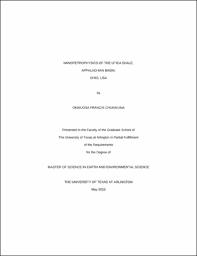
ATTENTION: The works hosted here are being migrated to a new repository that will consolidate resources, improve discoverability, and better show UTA's research impact on the global community. We will update authors as the migration progresses. Please see MavMatrix for more information.
Show simple item record
| dc.contributor.author | Chukwuma, Okwuosa Francis | |
| dc.date.accessioned | 2019-09-09T19:30:42Z | |
| dc.date.available | 2019-09-09T19:30:42Z | |
| dc.date.issued | 2015-05 | |
| dc.identifier.uri | http://hdl.handle.net/10106/28677 | |
| dc.description.abstract | The introduction of horizontal drilling combined with the ability to perform multiple-stage hydraulic fracture treatment has enabled the oil and gas industry to explore previously un-exploitable source formations, where it is estimated that 85% of the original reserves still resides. The application of these techniques provides economic gas and oil flow in extremely low porosity and permeability reservoirs. The Utica play, like the Bakken, Eagle ford Marcellus, Haynesville, Permian and Niobrara shales are the current focus for unconventional reservoir exploration in the United States where it is estimated that shale gas and oil production from these plays would reach 80 billion cubic feet per day and 9.6 million barrels per day respectively by the year 2020 (EIA, 2014) However, despite these recent advances in production techniques used in stimulating tight shale reservoirs, most shale wells are still characterized by overall low recovery and steady steep decline in production typical to unconventional plays. The Utica Shale is not excluded from this, with production from this play showing an initial decline rate of 65% after its first year of production. This may be as a result of the low pore connectivity and very narrow pores that affects movement of hydrocarbon from the shale matrix to the wellbore. A number of factors such as pvt, pore grain composition, multiphase fluid flow have also been attributed to this observed phenomenon in shale reservoirs. However, not a lot of research have gone into the pore structure of the nanopores storing and transporting hydrocarbon. This study will evaluate pore-size distribution and pore connectivity of Utica Shale samples obtained from J. Goins (GS-3), Prudential (1-A) and Fred Barth (#3) wells in Ohio. Using mercury intrusion porosimetry, fluid (DI water, API brine and n-decane) and tracer imbibition, and edge-only accessible porosity tests, we were able to investigate the pore structure, edge accessible porosity, and how wettability is associated with mineral and organic kerogen phases. The MICP tests gave us initial sample characterization of basic petrophysical properties (porosity, permeability, pore-size distribution, and tortuosity). We examined imbibition behavior, and imbibed tracer distribution, for fluids (API brine or n-decane) to examine the association of tracers with mineral or kerogen phases using LA-ICP-MS mapping to measure the presence of tracers in each fluid. Mercury intrusion capillary pressure analyses shows that the Utica pores are predominantly in the nanometer size range, with measured average pore-throat diameter of 4nm to 6nm across the study location. Imbibition slopes shows an evidence of low pore connectivity which is consistent with percolation theory interpretation of low connectivity and may be due to the observed small pore-throat distribution. These innovative approaches may hold the key to understanding fluid flow and pore structure in the nanopores by indicating the limited accessibility and connectivity in the Utica Shale and the implications these processes have in hydrocarbon recovery from the shale matrix into the fracture network. | en_US |
| dc.language.iso | en_US | en_US |
| dc.publisher | University of Texas at Arlington Libraries | en_US |
| dc.subject | LA-ICP-MS | en_US |
| dc.subject | Nanopetrophysics | en_US |
| dc.subject | Ohio | en_US |
| dc.subject | Petrophysics | en_US |
| dc.subject | Utica Shale | en_US |
| dc.title | NANOPETROPHYSICS OF THE UTICA SHALE, APPALACHIAN BASIN, OHIO, USA | en_US |
| dc.type | Thesis | en_US |
Files in this item
- Name:
- Chukwuma_uta_2502M_13115.pdf
- Size:
- 3.892Mb
- Format:
- PDF
- Description:
- Chukwuma Thesis 2015
This item appears in the following Collection(s)
Show simple item record


